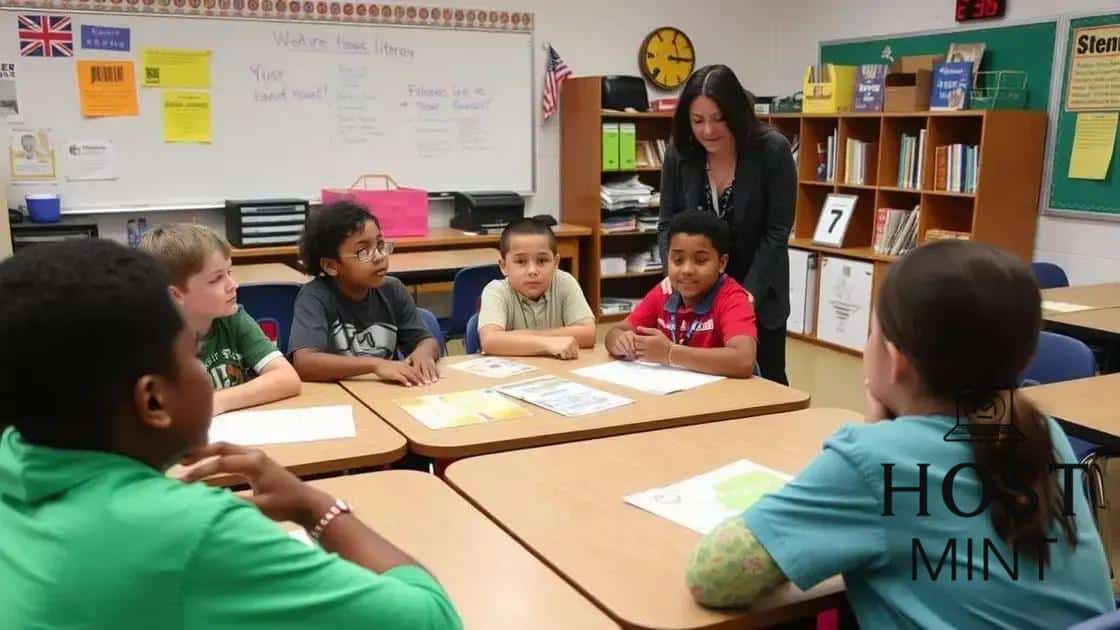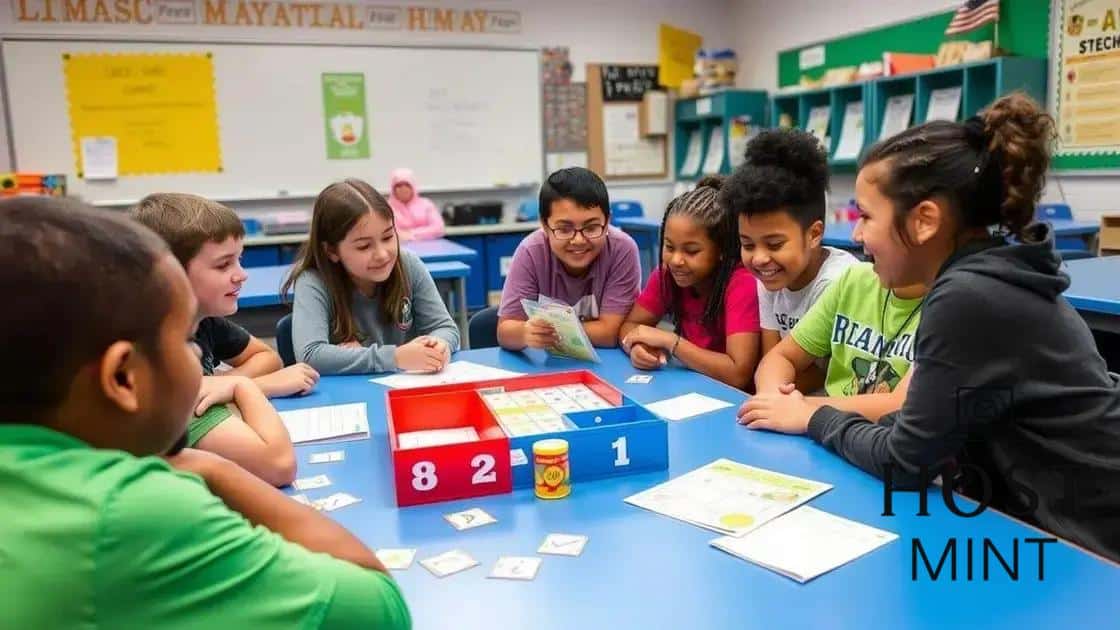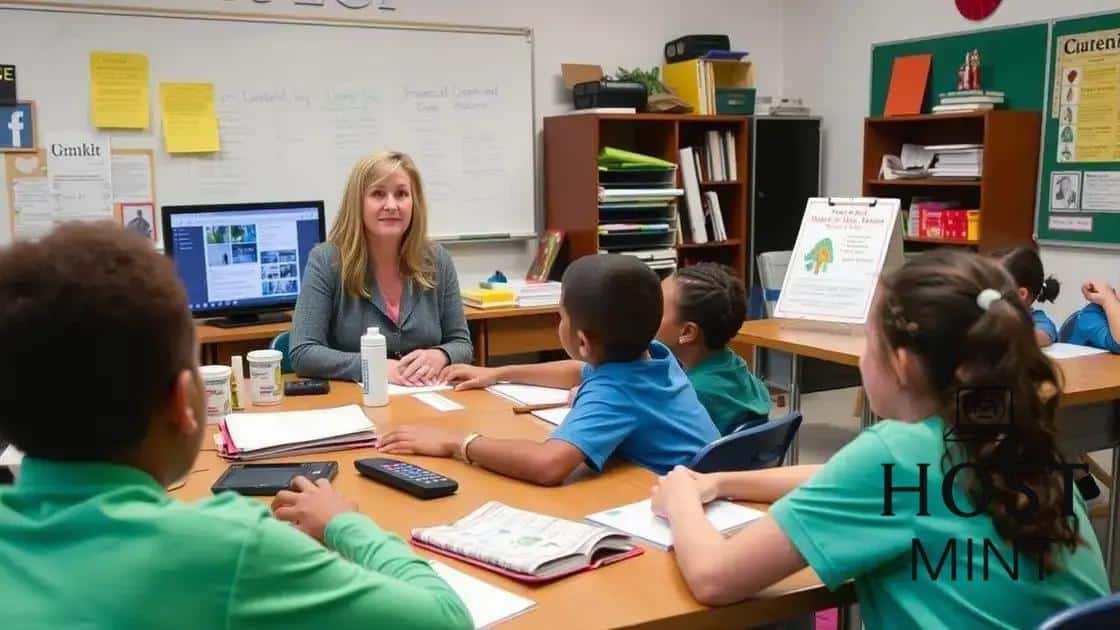Teaching financial literacy to middle school students: A guide

Teaching financial literacy to middle school students equips them with essential money management skills, empowering them to make informed financial decisions for their future.
Teaching financial literacy to middle school students sets them up for future success. Have you considered the impact of money management skills on their lives? Let’s dive into effective strategies that really work.
Understanding the importance of financial literacy
Understanding the importance of financial literacy is crucial for middle school students as it lays the foundation for their future financial decisions. Learning about money management at a young age can empower them to make informed choices later on.
When students grasp the basics of financial literacy, they become more prepared to face real-world challenges. It’s not just about saving; it’s about understanding how to budget and the value of money.
Benefits of Financial Literacy
Teaching financial literacy can lead to numerous benefits for students:
- Improved decision-making skills regarding spending
- Increased ability to save and invest money wisely
- Enhanced understanding of credit and its implications
- Prevention of debt accumulation and financial pitfalls
Additionally, incorporating financial literacy into the curriculum helps create a more financially responsible generation. This knowledge can influence their lifestyle choices and even inspire them to pursue careers in finance or related fields.
Why Start Early?
Starting financial education early unlocks potential life skills. Students learn about compound interest, which can grow savings over time. They also discover budgeting strategies that can help them navigate through their teenage years and beyond.
These lessons lead to healthier financial habits. As they grow older, they will likely handle their finances better, reducing anxiety around money issues. It also promotes skills like goal-setting and delayed gratification, which are valuable throughout life.
Involving parents in the conversations about money can amplify the impact of what students learn in school. Open discussions at home about financial topics help reinforce the importance of financial knowledge. Schools can provide resources to encourage these conversations, ensuring that students see the real-life applications of their lessons.
Ultimately, understanding the importance of financial literacy equips students not just for school projects but for their entire adult lives. The skills and concepts they learn will serve them long after they leave the classroom.
Creative ways to teach financial concepts

There are many creative ways to teach financial concepts to middle school students. Engaging activities can make learning about money fun and memorable. Here are some innovative methods that educators can use to bring these important lessons to life.
Incorporating Games
Games are a fantastic way to teach financial concepts. They can simplify complex ideas and make them entertaining. Consider using:
- Board games that simulate economic scenarios.
- Online financial literacy games that allow students to make virtual spending choices.
- Role-playing activities where students can act out different financial situations.
These games help students to understand concepts like budgeting, saving, and investing in a hands-on way.
Real-World Projects
Another fun method is to involve students in real-world projects. This can include:
- Creating a mock business plan where students budget for expenses and revenues.
- Organizing a school store where they must manage inventory and pricing.
- Handling a class fundraiser, teaching them how to allocate and spend funds wisely.
Such projects encourage teamwork and allow students to see the impact of financial decision-making. They gain practical experience in managing money, which is invaluable.
Field trips can also enhance financial learning. Visiting banks or businesses allows students to see financial concepts applied in real life.
Teachers can also integrate technology into financial education. Using apps for budgeting can help students visualize their spending and saving goals. Workshops led by financial professionals can offer firsthand insight into managing money, making the lessons more relatable and vivid.
By using these creative teaching methods, educators can make financial literacy exciting for students. It’s essential to find innovative ways to connect with young learners, ensuring that they grasp the vital importance of managing their finances.
Incorporating real-life scenarios in lessons
Incorporating real-life scenarios in lessons is an excellent way to teach students about financial literacy. When students see how financial concepts apply in their everyday lives, they are more likely to understand and remember them.
Using relatable examples can make lessons more engaging. For instance, teachers could present a scenario where a student wants to buy a phone. They can analyze how much money needs to be saved and what it means to budget for that purchase.
Examples of Real-Life Scenarios
Teachers can draw from various real-life situations that students encounter:
- Planning a birthday party, including budgeting for food, decorations, and entertainment.
- Deciding whether to buy a new video game or save for a more expensive gadget.
- Understanding monthly allowances versus spending habits.
These examples help students develop critical thinking about money management. They not only learn about saving and budgeting but also about making decisions based on their goals. Presenting scenarios helps students to relate to financial challenges in a way that resonates with their experiences.
Group activities can also simulate real-life situations. Students can work in teams to solve financial puzzles or case studies, giving them a chance to collaborate and share ideas. As they discuss solutions, they will consider different perspectives and strategies, enhancing their understanding of financial planning.
Using Technology
Integrating technology can further enhance these learning experiences. Interactive apps or websites can provide students with scenarios that require them to make financial decisions. They can track their progress as they learn about costs and savings.
Moreover, inviting guest speakers, such as financial planners, can bring additional insights into the classroom. Professionals can share their experiences and provide context to financial principles, reinforcing the lessons with real-world implications.
By incorporating real-life scenarios into lessons, educators can create a relevant and impactful learning environment. This connection between classroom concepts and daily experiences makes financial literacy tangible and meaningful for students.
Tools and resources for educators

When teaching financial literacy, having the right tools and resources for educators can make all the difference. These resources not only enhance lessons but also engage students effectively.
One of the best tools available is interactive websites and apps that focus on financial education. These platforms often include simulations, quizzes, and games designed to reinforce important concepts. For example, some apps allow students to create budgets or manage a virtual bank account.
Recommended Websites
Here are some useful websites that educators can explore:
- Jump$tart Coalition: This organization offers resources and curriculum guides for financial education across different grade levels.
- National Endowment for Financial Education: This site provides comprehensive materials for teachers and students, including lesson plans and activity guides.
- CashCourse: A financial literacy platform designed specifically for students that includes helpful articles and tools.
These websites are packed with ideas that can inspire lesson plans and classroom activities. By using them, teachers can easily find age-appropriate content that aligns with their curriculum goals.
Classroom Activities and Materials
Incorporating hands-on activities can also energize lessons. Educators can use real-life scenarios to create engaging projects. Tools such as worksheets, budgeting templates, and visual aids help students visualize financial concepts more clearly.
Additionally, utilizing manipulatives like play money can add a fun aspect to lessons on currency and change. Teachers can set up mock stores where students practice making purchases and giving change, helping them gain confidence in their money management skills.
Workshops or guest speakers from the financial industry can also enrich the learning experience. They provide students with real-world insights into money management and inspire future career paths. Resources available through local banks or credit unions often include programs tailored for schools.
By leveraging various tools and resources, educators can create a diverse and engaging learning environment for financial literacy. This approach not only benefits students but also empowers teachers with innovative strategies to make complex ideas more accessible.
Engaging parents in financial education
Engaging parents in financial education is essential for reinforcing what students learn in the classroom. When parents are involved, students are more likely to understand the importance of managing their money wisely.
One effective strategy is hosting workshops that invite parents to learn alongside their children. These workshops can cover basic financial concepts, such as budgeting and saving, in an interactive format. Parents who understand these principles can better guide their children at home.
Creating Resources for Parents
Providing resources, such as handbooks or online guides, can help parents support their children’s financial learning. These resources can include:
- Tips for discussing money matters openly at home.
- Activities parents can do with their children to reinforce financial concepts.
- Webinars featuring financial experts discussing important topics.
These materials empower parents with the knowledge they need to participate actively in their children’s financial education journey.
Encouraging Open Communication
Encouraging open communication about finances is another vital aspect. Schools can send home newsletters with financial tips or topics being covered in class. Parents would feel more equipped to engage in discussions with their children.
Additionally, schools can host family events centered on financial literacy, where families can work together on fun activities or challenges that teach financial principles. Examples include budgeting competitions or creating savings plans together.
Having parents share their experiences with money can also provide valuable lessons. When children hear real stories from their parents about how financial decisions were made, it brings theory into practice and makes concepts more tangible.
To further support this engagement, schools can form partnerships with local banks or financial institutions. These partnerships can provide access to community resources that enhance financial education programs, offering workshops and seminars tailored for families.
By actively involving parents in financial education, schools create an environment where financial literacy can thrive. This cooperation ensures that students practice responsible money management both at school and at home.
FAQ – Frequently Asked Questions about Teaching Financial Literacy
Why is financial literacy important for middle school students?
Financial literacy equips students with essential money management skills, helping them make informed decisions for their future.
How can I engage parents in financial education?
Invite parents to workshops, provide resources, and encourage open discussions about money at home.
What activities can make financial education fun?
Incorporating games, real-life scenarios, and hands-on projects can make learning about finances exciting and relatable.
What resources are available for teachers?
Educators can access websites, apps, and community partnerships to enhance their financial literacy lessons.






